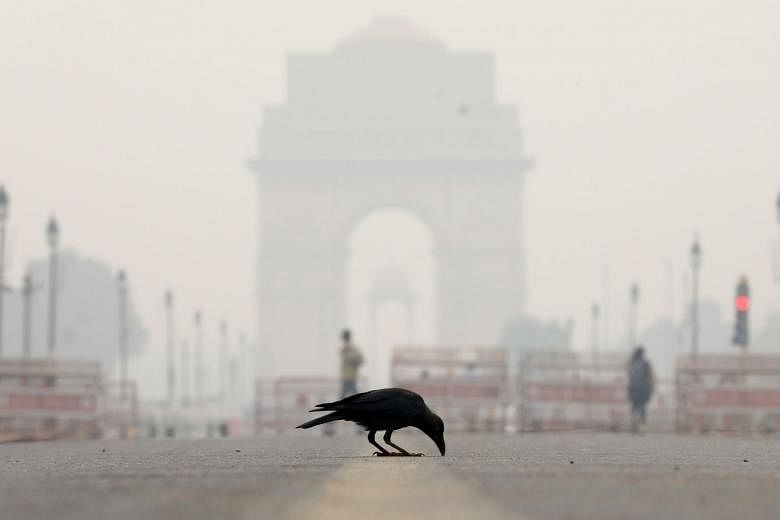BANGALORE - Conversations in Delhi today are punctuated with coughs and existential questions.
As pollution readings reach record highs in the city, the 20 million residents wonder how the smog can lift, and when they will be able to breathe freely again.
Mr Siddharth Singh, the author of The Great Smog Of India that chronicles northern India's struggle for clean air, observed that far more people are aware and angry about pollution today.
"It's better for an issue to be politicised than be entirely ignored as it was for a long time, because it encourages public debate, ideas and willingness for change," he said.
As soon as the Air Quality Index went beyond 300 in mid-October, signifying "very poor" levels, Delhi switched to the Graded Response Action Plan (GRAP), operating since 2017.
The emergency response stops the use of diesel generators, closes brick kilns and stone crushers, and fines people burning garbage. It discourages private vehicles on roads by hiking parking fees and establishing a roster for vehicles with odd and even-number registration plates to stay off the road on alternate days.
This winter, over 300 official teams have imposed more than 99,000 fines on violators.
Ms Anumita Roy Chowdhury, who heads the air pollution team at the Delhi-based non-profit Centre of Science and Environment, said that in the last decade, the government had closed coal power plants within city limits, established metro rail, and converted buses and auto rickshaws to using low-emission natural gas.
The Supreme Court recently banned two sources of pollution in winter: fire crackers for the festival of Deepavali and burning of wheat crop stubble by farmers in neighbouring states.
"If you look at decadal trends, focused government action and court orders have reduced the concentration of harmful particulate matter in the air. But overall, it is still too high," said Ms Roy Chowdhury.
She believes Delhi needs a 60 per cent decrease in emissions to meet clean air standards.
Experts stress the need for long-term regulations and stricter implementation.
"All the soft options are over. Our new regulations are going to need much more hard decisions," said Ms Roy Chowdhury.
Dr Sarath Guttikunda, founder of Urban Emissions that does pollution analysis, said: "A holistic plan must include a long-term plan that covers all the known sectors. The best solution to control pollution is to cut the emissions at all the sources."
The Central Pollution Control Board currently regulates polluters and monitors air quality with state level offices. But analysts are unanimous that it is time to start strong coordination across environment, power, transport and health departments in the country.
"Air pollution is not Delhi-specific or winter-specific. Much of the Indo-Gangetic plains has very poor air quality, and Delhi happens to be at the centre of it," said Mr Santosh Harish, who works on air pollution regulation at Delhi's Centre for Policy Research. "It is a regional problem that requires long-term regional-level solutions."
Some important national-level steps have been taken. India will jump from its current Euro 4 vehicle emission standards to Euro 6 by March 2020 to reduce exhaust in petrol and diesel cars.
Prime Minister Narendra Modi also announced the world's most ambitious solar energy target of 100 gigawatts by 2022.
"We may fall short of the solar target, but if this wasn't announced (in the 2015 Paris Climate Summit), all that power would have come from high emission coal," said Mr Singh.
Analysts said India's plans suffer from lackadaisical enforcement and lack of coordination. There are few penalties, and little transparency.
"You can't have clean air unless you see pollution as a structural problem. This means you can't have only one villain, like the stubble-burning farmers," said Ms Shweta Narayan, coordinator at the Healthy Energy Initiative.
She pointed out that across India, there were weak taxes on diesel luxury vehicles, none on diesel-fuelled generators, and no waste management plan to replace the practice of burning garbage in landfills.
Coal-based power plants are barely regulated. Four thermal power plants were moved out of Delhi a decade ago, but those in the 300km radius, totalling 13.2 GW, continue to fill the air with particulate matter, sulphur dioxide and nitrogen oxides.
In December 2015, the ministry of environment had announced new strict emission norms for coal-based power plants across the country.
"The 33 coal plants near Delhi had to comply by December 2019. Only two have complied till now!" said Mr Harish.
Mr Ronak Sutaria, founder of Respirer Living Sciences, which makes real-time air quality monitor Atmos, said India needs more data to build local-level action plans. The country has 200 real-time air quality monitors (37 in Delhi), but he said it needs 8,000 to 9,000.
"Industries need 24/7 monitoring and the data should be made public - of the 4,000 industries in Mumbai that are supposed to report their data, none are known to us. How will we ensure compliance then?"
Ms Narayan said that while targeting the source of pollution, the government "must develop health infrastructure to provide subsidised treatment for sick people".
Based in Chennai, Ms Narayan said that the southern city was also seeing "pathetic air quality".
Regions like coal mining hotbed Korba in central India and industrialised Ennore in Tamil Nadu have hazardous air quality almost throughout the year.
"Pollution is a transboundary problem, and needs an overhaul of the way we live. Delhi will breathe clean air when Korba has clean air," she said.



